Swedish pioneers in Clinical Neuroscience – focusing on neuromuscular diseases
by Lars Edström
In the middle of the 19th Century the knowledge of Neurology among Swedish universities were represented by academic representatives from general Internal Medicine.
Of historic interest is Professor of Internal Medicine in Karolinska Institutet Per-Henrik Malmsten. He was engaged in what we now call “evidence based medicine” and fought i.e. against the frequent use of venesectio, at that time a common way to treat pneumonia.
When Malmsten, who was born in a poor family, died after a professional life including i.e. a huge private practice, he was a wealthy person and his heirs donated 100.000 Swedish Crowns to Karolinska Institutet for introducing a chair in “a specific clinical branch”. The medical faculty agreed in recruiting a Professor’s position in Neurology in 1889, the first in Sweden and the basis for development of neurological departments in the rest of the Swedish universities during the 20th century.
Of paramount importance for a successful development of clinical neurophysiology and the field of neurology focusing on neuromuscular disorders was the achievement of Ragnar Granit, who had been called to a chair in physiology at the Karolinska Institute.
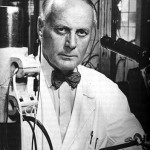
Granit had a chairmanship in Helsinki Finland and his recruitment to Stockholm resulted in an important injection of neurophysiological know-how and foremost development of techniques which was important for the clinical methodology as well as medical care.
Among Ph.D students in Granit’s laboratory was Eric Kugelberg who presented his thesis in 1944.
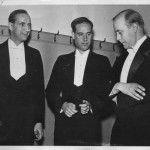
He became associate Professor of Clinical Neurophysiology in 1947 and produced a series of classical works on electromyography (EMG) i.e. the myopathic and neurogenic EMG. He opened up the first laboratory for clinical neurophysiology in Sweden.
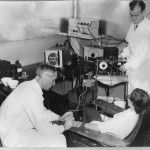
Eric Kugelberg became Malmstenian Professor of Neurology in 1954.
Another Ph.D. student in Granit’s laboratory was Lars Leksell, who then made important observations on the gamma-motoneurone system. Soon he became Professor in Neurosurgery at Karolinska Institute and was a pioneer in using stereotactic methods in neurosurgery.
Kugelberg’s collaboration with Lisa Welander, a resident in the Department of Neurology, resulted in the identification of a juvenile form of spinal muscle atrophy, which had before been looked upon as a muscle dystrophy, now called Kugelberg-Welander’s disease. A key to the correct diagnosis was EMG.
Furthermore, Lisa Welander made studies on a late onset hereditary disorder, which was found to be comparatively frequent in some areas of Middle Sweden and also in Finland. The new techniques available, distinguished the disorder as a myopathy. Now we know that the families in Finland are genotypically identical with the Swedish.
Lisa Wallander was appointed as Professor in neurology in 1964 at the new university in Umeå. She was the first female in the country in that position.
Gunnar Wohlfart started his academic career at the histology department at Karolinska Institutet and trained neurology after moving to the Serafimer University Hospital. He is known for his muscle tissue studies in neuromuscular disorders, foremost muscle dystrophies.
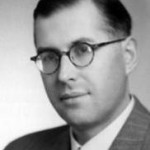
He probably described the juvenile spinal atrophy independently of Kugelberg and Welander. He also published papers about Grunt´s syndrome together with Ingrid Gamstorp. Gunnar Wohlfart got a chair in Lund which he held until his demise in 1961.
Ingrid Gamstorp was child neurologist and first at Lund University; later she was Professor at Uppsala University. She is well-known for her work on periodic paralyses and foremost for an autosomal dominantly inherited hyperkalemicform (Gamstorp’s disease).
Going back to Clinical Neurophysiology, Erik Stålberg is an internationally very distinguished scientist and lecturer, partly because of his successful research and partly because of his enthusiasm in sharing his unique methodological knowledge all over the world to interested trainees.
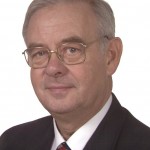
He presented his thesis on single fibre EMG (SFEMG) in 1966. Since then he has developed a number of methods e.g. macro EMG, scanning EMG and methods for quantitative analysis and telemetry.
Erik Stålberg was Professor of Clinical Neurophysiology at Uppsala University from 1991 to 2001.
Lars Edström is Professor of Neurology at the Karolinska Institutet in Stockholm, Sweden. He will present his lecture “Swedish pioneers in neuromuscular diseases and neurophysiology: Kugelberg, Wohlfart, Welander, Stalberg, Granit” during the Special Session on Chapters in the history of Swedish Neuroscience during the EFNS Congress in Stockholm, Sweden.



